Hi everyone, and welcome back to another week in the Mirror Gallery. Last time we got to hear from Lindsey Look about her latest work for Dominaria, Powerstone Shard, and its journey from her easel in Connecticut to my collection here in Maryland. This time I want to unpack the image and place it in a larger context alongside some other pieces of Magic art.
Let’s start holding the card at arm’s length. There are two things particularly striking about Powerstone Shard: the hand holding the piece of powerstone, and then the shard itself.
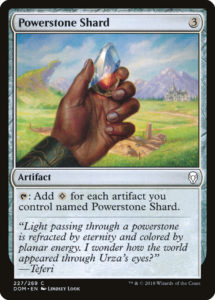
This Part II was originally going to be an article about powerstones: what they were, why they were important, and their depiction through the history of magic art. I started playing Magic during Onslaught, so the lore and importance of powerstones to the greater Magic story arc is not something I was particularly familiar with. Resident Vorthos and Raven Man-enthusiast Jay Annelli directed me to an article he wrote. It’s full of his great research and will fill in any blanks about powerstones you may have. But feeling like I didn’t have much to add in terms of how powerstones have been depicted in Magic illustration, I looked to the other component of Powerstone Shard: the hand.
The Hands of Art History
The second element that makes Powerstone Shard so striking is that prominent hand in the foreground. Magic has a long history of card illustrations where a hand, often unknown, is holding an important object or artifact. From all that I’ve studied in art history up to the specific research done for this article, this aesthetic of just the “hand holding something” does not really exist in great quantity outside the art direction for Magic. We are going to explore hand-focused art in greater realm of art history, delve into hand-related depcitions in Magic, and end with situating Powerstone Shard and Lindesey Look’s body of work among the master hand illustrators of Magic: the Gathering
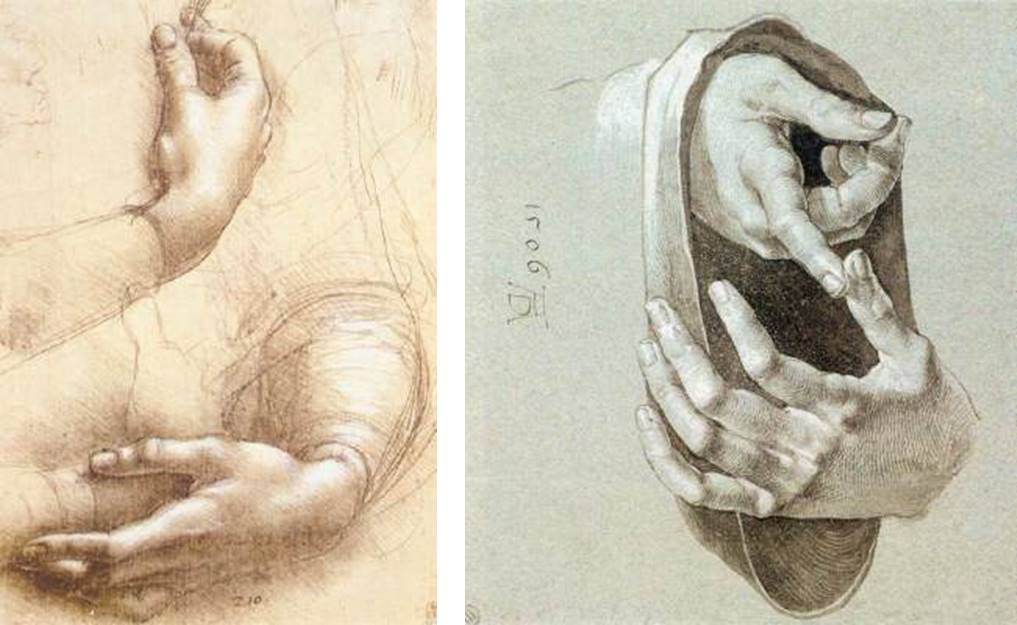
(Left), Leonardo da Vinci, Study of Hands, c. 1474, Silverpoint and white highlights on pink prepared paper, 214 x 150 mm (8.4” x 5.9”), in the collection of the Royal Library, Windsor. Image from the Web Gallery of Art, www.wga.hu. (Right) Albrecht Durer, Study of Hands, 1506, Brush, gray and black ink, gray wash on paper, 207 x 185 mm (8.1” x 7.3”), in the collection of the Germanisches Nationalmuseum, Nuremberg. Image from the Web Gallery of Art, www.wga.hu.
Hands by themselves have been a subject of artists long before Magic. The above examples by Leonardo da Vinci and Albrecht Durer of hand studies were rendered over 500 years ago, about 20 years apart, during the height of the European Renaissance. They are precise and exacting, emphasizing form and proportion in an attempt to make them as real a depiction as possible.
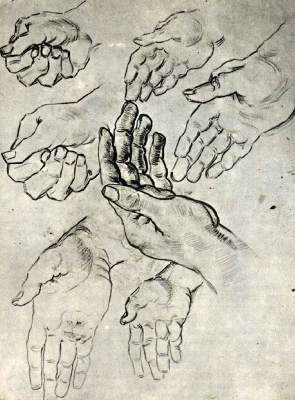
Vincent Van Gogh, Study Sheet with Seven Hands, January-February 1885, Nuenen, Black pencil, 330 x 254 mm (10” x 13”), collection of the Rijksmuseum Vincent van Gogh, Amsterdam. Image from the Web Gallery of Art, www.wga.hu
Fast forward almost 400 years and we have another study of hands by Vincent Van Gogh, c.1885. Art has changed stylistically, yet the study of hands has not. These are executed in the same manner but by a post-Impressionist mind, moving away from Renaissance realism to more geometric and distorted forms as was Van Gogh’s and the period’s style.
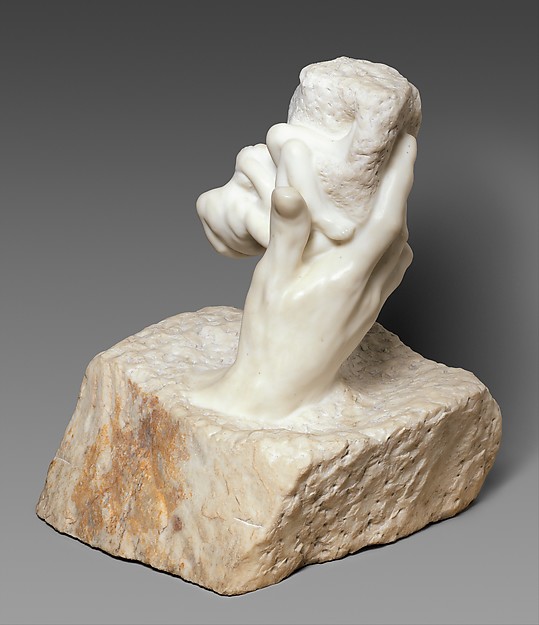
Auguste Rodin, The Hand of God, carved marble, c,1907, 29” × 23.75” × 25.25,” 508 lb., collection of The Metropolitan Museum of New York
Let’s jump again in time. We get even closer to what we see in Magic in Auguste Rodin’s c.1907 Hand of God seen above, this one in the collection of the Metropolitan Museum of Art in New York. Beautifully sculpted yet disembodied hands are signature of Rodin’s work, and in this case the hand, purportedly of God himself, cradles Adam and Eve as if a precious jewel or medallion.
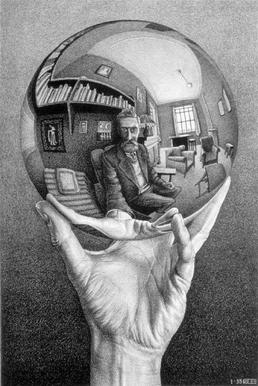
M.C. Escher, Hand with Reflecting Sphere, or Self-Portrait in Spherical Mirror, lithograph, c.1935, 12.5” × 8.4”
When I first wrote this article, I completely missed Escher’s Hand with Reflecting Sphere. I sent it to my best friend Joe, as I do much of my writing, to edit out all the dumb and colloquial stuff I write before I send it to my editor. He said, “Disappointed you didn’t add an Escher. Either Drawing Hands or Self Portrait (it has a hand holding a thing!)” Total whiff on my part, and good catch Joe. The idea of Escher depicting himself as a reflection is a direct representation of his work both literally and figuratively, saying volumes with no words at all. This type of storytelling is also seen in Magic, and we’ll investigate this in just a bit.
We covered over 425 years of hand-related art in about 200 words, but I’d like to look at just one more. Rewind with me back to the Renaissance, and let’s look at Sandro Botticelli’s Portrait of a Man with a Medal of Cosimo the Elder and see if we can forge a direct link to Magic.
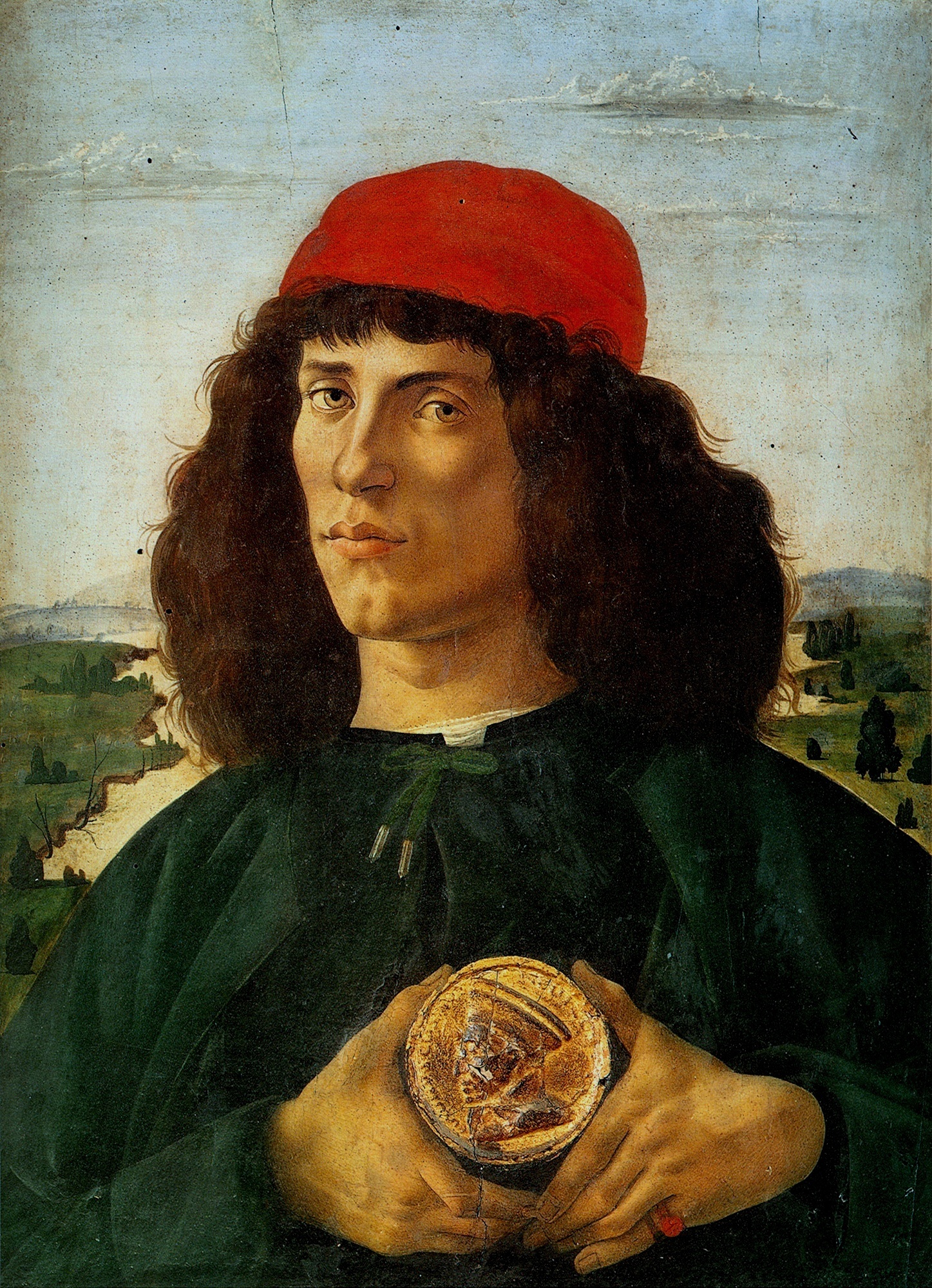
Sandro Botticelli, Portrait of a Man with a Medal of Cosimo (de’ Medici) the Elder, or Man with a Medal, c. 1474, Tempera on panel, 57.5 x 44 cm (22.6” x 17.3”), in the collection of the Galleria degli Uffizi, Florence.
It’s reasonably rare for portraits of this time to be painted holding objects like this, as it draws the viewer to the object as opposed to the figure. History has been concerned with the identity of the unknown sitter, but for our exploration today we focus on the medal, a plaster-gessoed cast, created separately and then set into the painting. The medal is the focal point, and Botticelli wants you to pay attention to it.
So what if we focus only on that, cropping it down to just the medal? Would it look out of place within a Magic card frame? Could it fit into the tradition of hands holding important artifacts?
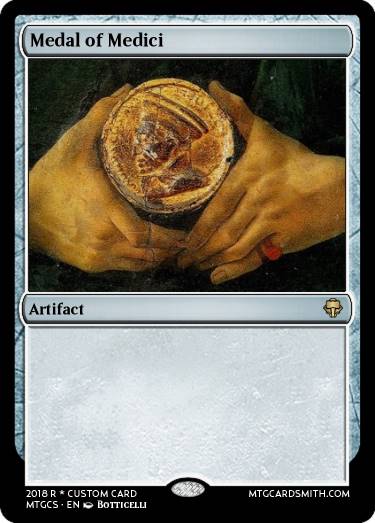
Card created using MTG Cardsmith https://mtgcardsmith.com/
If you saw this card in Core Set 2019, the visual tradition of hands holding things in Magic would let this fit right in. The illustrations we find in Magic of disembodied hands holding important objects exist as if a detail of a larger portrait cropped to fit the card box, just like what we did above, and that’s part of what makes them so intriguing and such a rich part of Magic’s storytelling.
The Hands of Magic
I mentioned in my last article that in researching Powerstone Shard, Lindsey Look’s oeuvre, or body of work, is heavily made up of hand related illustrations for Magic. This places her in the company of those that used to do near all the hand commissions, the likes of masters Donato Giancola and his former student Volkan Baga. These three artists have not done every hand related illustration, but it’s fair to say they have done a majority. Most players will recognize their illustrations on a piece of cardboard, but so much can be lost at card size the viewer often misses the illustrative triumph outside the context of the card. Let’s fix that.
We’re going to go all the way back to the early days of the game, focusing specifically on the idea of a human hand displaying an important object. I’ll show you the change over time, and highlight some of the best pieces to be seen in Magic in this sub-genre. Many of these images are not available in high resolution online simply due to their age, so I apologize in advance that some may not be as clear. Immense thanks to the Scryfall team that has taken to the time to ensure a zoom of every artwork is available on their tagger website, which is where many of these older images were pulled from. What you will find is that even at low resolution; much of this art is simply incredible.
The Early Days
From the earliest days of Magic, there were artifacts and objects shown being held by a hand. It showed their importance, and created a simple point of reference outside of an object floating arbitrarily in the negative space of a card box.
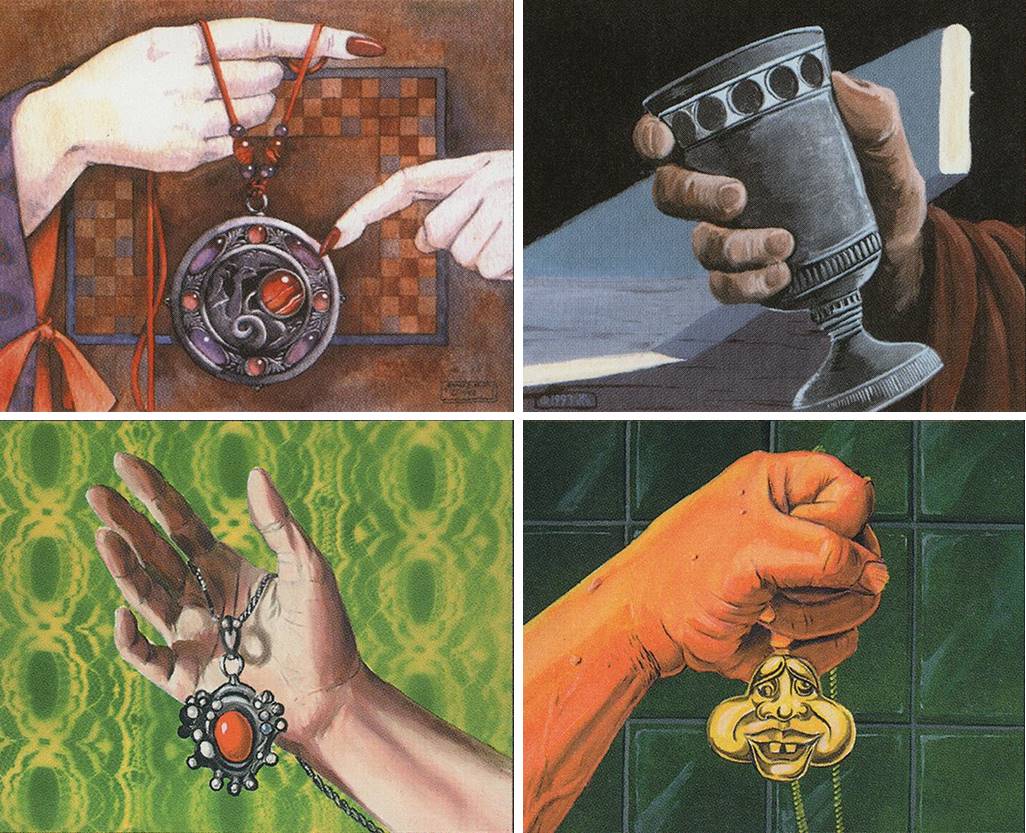
Clockwise from Top Left: Amulet of Kroog by Margaret Organ-Kean (Antiquities), Urza’s Chalice by Jeff Menges (Antiquities), Amulet of Quoz by Dan Frazier (Ice Age), Jeweled Amulet by Dan Frazier (Ice Age). Traditional.
These illustrations are from a different time in Magic; the game was brand new, the art direction was different, and the fact that each card had its own commissioned work was a radical idea at the time. This is what Magic looked like in 1993-1995, and although the art would change, the composition of a “hand holding something” would continue.
The Singletons
There are lots of artists that have created one or two pieces that fall into this subcategory of hands in Magic art. These illustrations run the full stylistic gambit, from the early illustrations we saw above to some hyper realistic, contemporary examples. The ones below are by no means fully representative of every example, I simply want to illustrate that the fact that there have been many artists that did one or two hand illustrations, and that they do not all look alike regardless of when they were created.
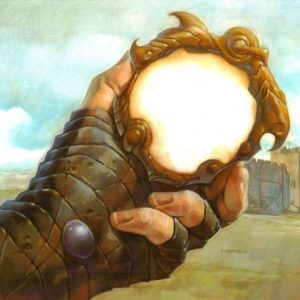
Dave Dorman, Urza’s Filter (Invasion), 2000. Traditional, original sold.
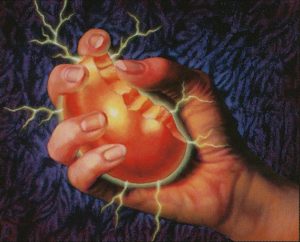
David Martin, Meekstone, (7th Edition), 2001
David Martin actually did a number of hand-related illustrations, including the Diamond series that was later reimagined by Lindsey Look for Magic Online/ Commander 2014. Several of his renditions include gloved/ non-human hands, so for the purpose of this article I’ve only included Meekstone.
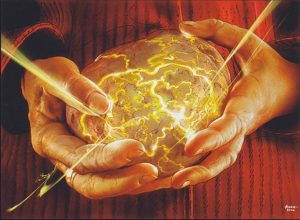
John Avon, Fellwar Stone, (9th Edition), 2005
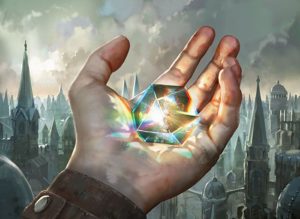
Daniel Ljunggren, Prophetic Prism, (Gatecrash), 2013. Digital
From early days on Dominaria to Ravnica to unnamed places in between, we see the hand tradition has remained strong through the game’s history. Let’s go one step further.
The Big Three
As I mentioned earlier, as the game evolved a few artists become the “hand” artists. Again, not to say that others weren’t commissioned to do hands, but hand depictions began to be commissioned very specifically. The first was Donato Giancola. I said earlier I use tagger.scryfall.com on the regular, and this article was no different. Go to the site and search for the tag “hand,” and scroll through the images.
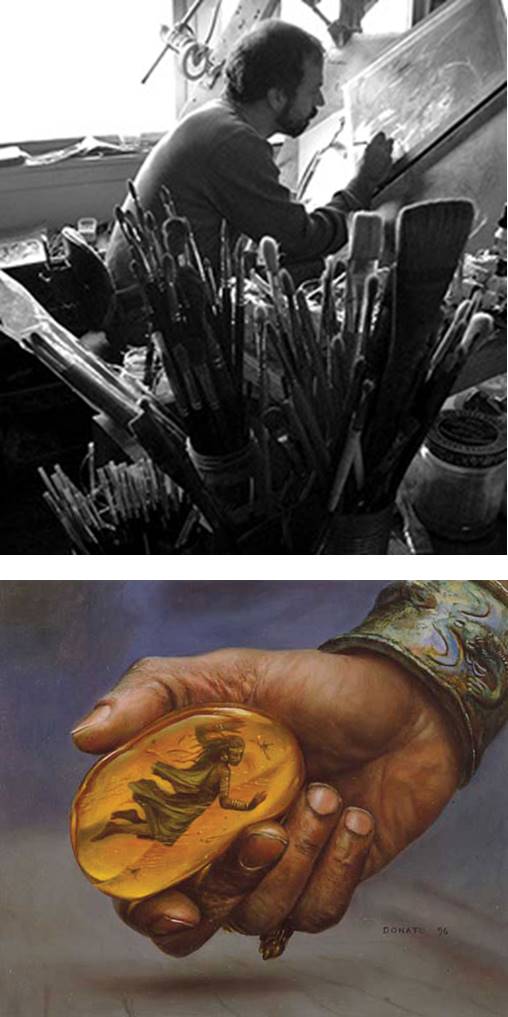
Amber Prison by Donato Giancola, Oil on Paper on Masonite, 11.25″ x 9.75″ Oil on Paper on Masonite, in the collection of the artist.
There will be about a dozen that stop you in your tracks for a second look. These are the works by Donato Giancola.
Those cards you just paused at that weren’t Donato? Those were probably Volkan Baga.
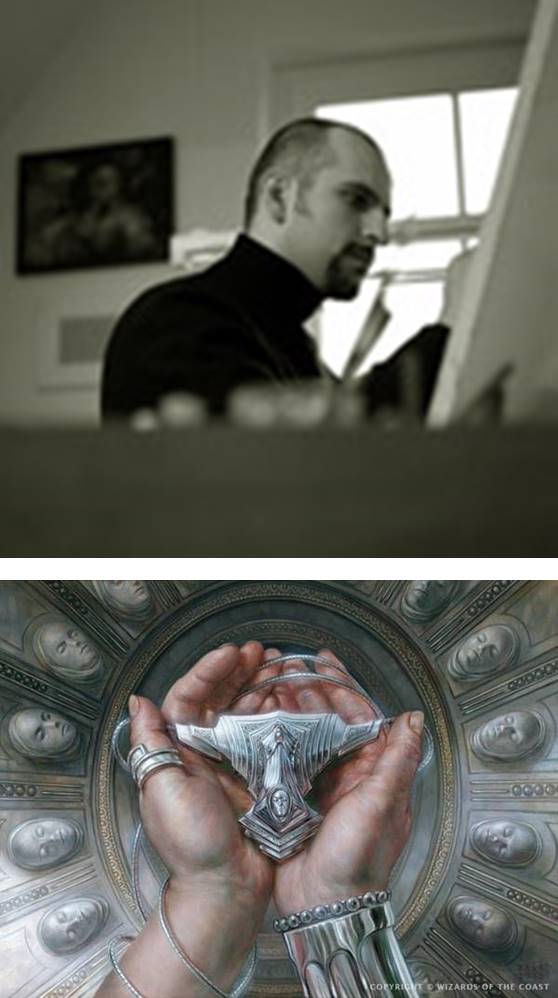
Chrome Mox by Volkan Baga, oil on board, 13” x 17.3” (Original Sold)
Volkan was former studio assistant to Donato, and his work reflects that in style and skill. Baga’s illustrated hands hold almost exclusively Moxen, and he has illustrated every non-Un-set rendition of Mox the game has seen up until the just-released Mox Amber by Steven Belledin, which is an equally incredible work of art.
Donato’s last illustration before the recently-released Serra Angel and set of Grand Prix promotional lands was in Magic 2012. Volkan is still currently illustrating for Magic; we see his work on two or three cards a set and when Magic needs new art for high profile or promotional card. Their work has and continues to transcend the game, and we as players and fans are fortunate for every illustration these two artists do for Magic.
Having traced Magic’s storied history of hand illustrations, and shown they are a core aesthetic since the game’s earliest days; we have proven the tradition will continue, and not just anyone can pick up this banner. Mike Linnemann said it in 2016, and I said it two weeks ago. Who is Magic’s new hand artist to walk alongside Donato and Volkan? It’s Lindsey Look.
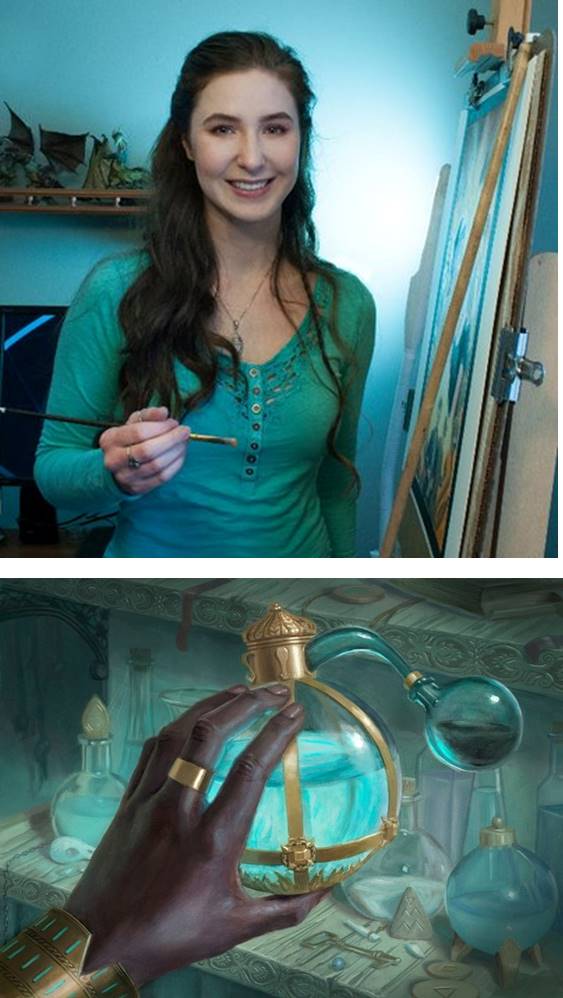
Mystical Tutor by Lindsey Look, oil on board, 11” x 15” (Original Sold)
Her first six Magic commissions—the Diamond cycle—were hands, and this set the stage. Her Mystical Tutor is an incredible re-envisioning of the iconic card, and likewise soared to $8,300 when she sold it upon the set’s release, a testament to its strength as a work of art and iconic status as a card. Her latest work, Powerstone Shard, is so simple yet so complex, from the translucence of the stone to the energy within that dances as if a firefly on a summer night. You can feel the intrigue of the holder just by the posture and position of their hand, and the image tells a tale of discovery.
Look at her hands in Magic.
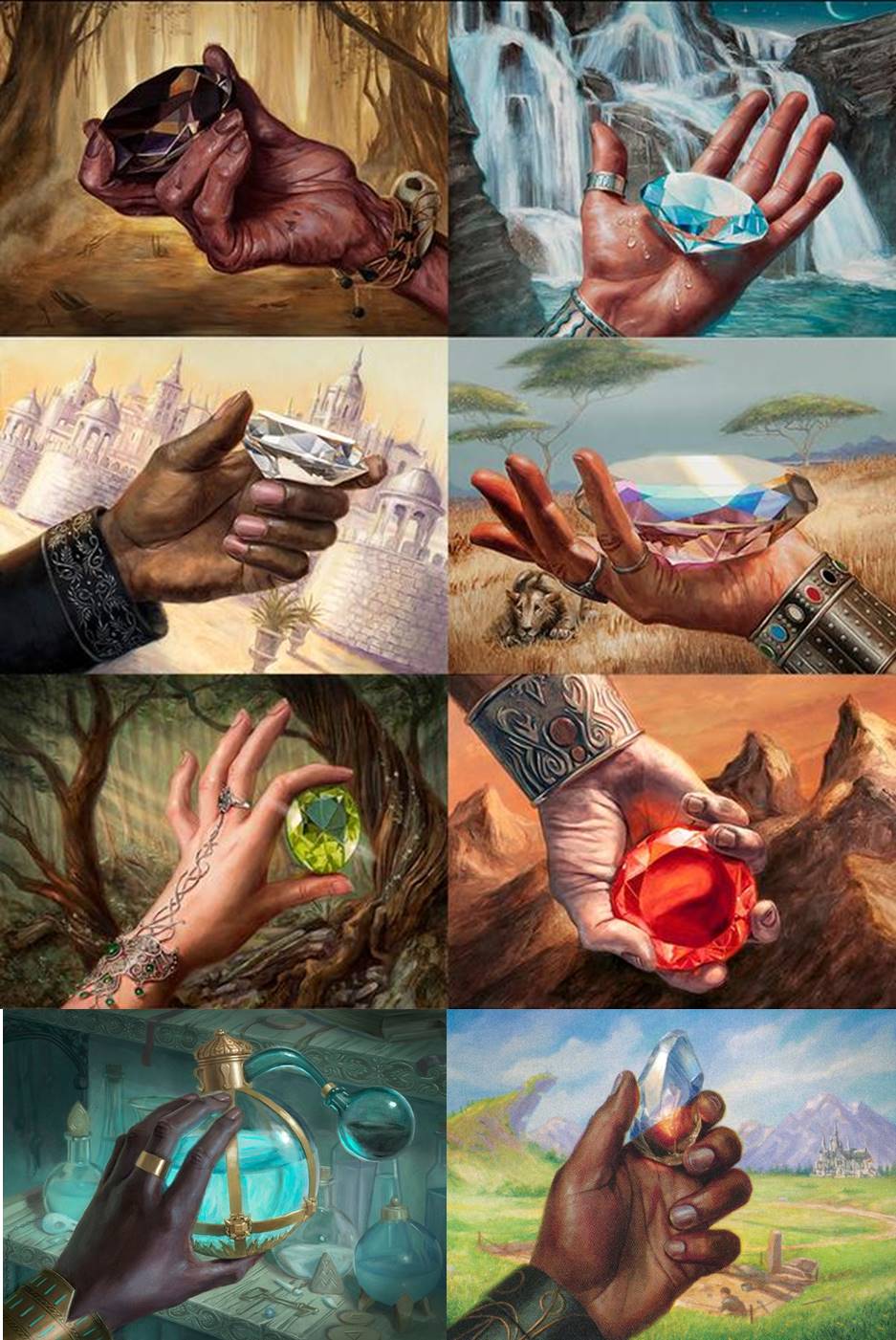
Lindsey Look’s Hand of Magic. All Traditional.
Will she be the next to do the cycle of Moxen? She should be.
Look at her book cover illustrations and personal work outside of Magic.
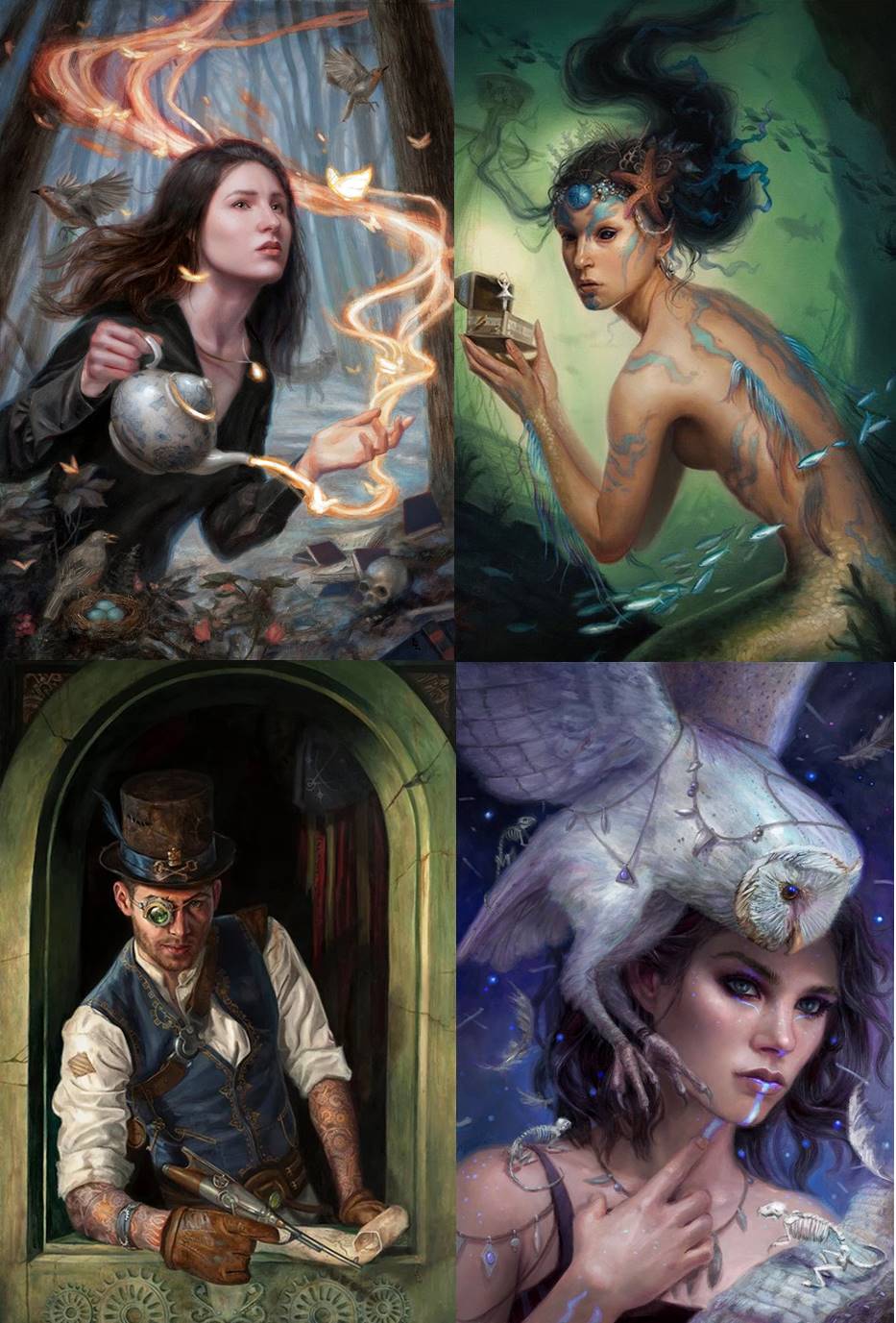
Personal Work by Lindsey Look, Images courtesy of the artist.
Is there a Planeswalker on the horizon? Again, there should be.
Purpose to the Pose
We are going to end on some comparative story-telling collages. I mentioned the story-telling components great art can have throughout this article, so let’s bring it home with our signature hand artists of Magic. The following images include one by Donato Giancola, one by Volkan Baga, and one by Lindsey Look, in that order. Look close at these illustrations beyond the card frame. Think about what the artist is trying to convey with only hands and a single object.
Treasure
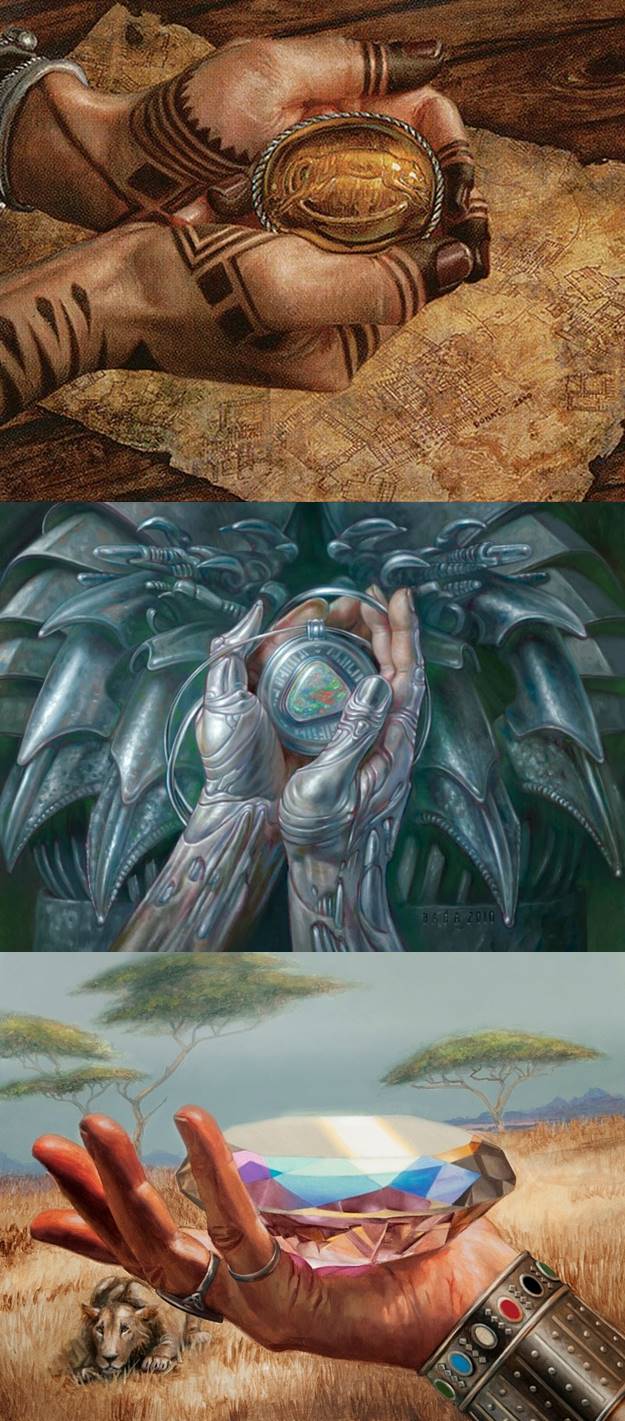
Tiger Eye Cameo by Donato Giancola, Mox Opal by Volkan Baga, Lion’s Eye Diamond by Lindsey Look
Tiger eye, opal, and diamond; the first two held carefully in two cupped hands to keep the jewel safe, the last displayed in an open palm yet safely and securely accounted for. The fineness of these objects is apparent, and their magnificence is unmistakable.
Discovery
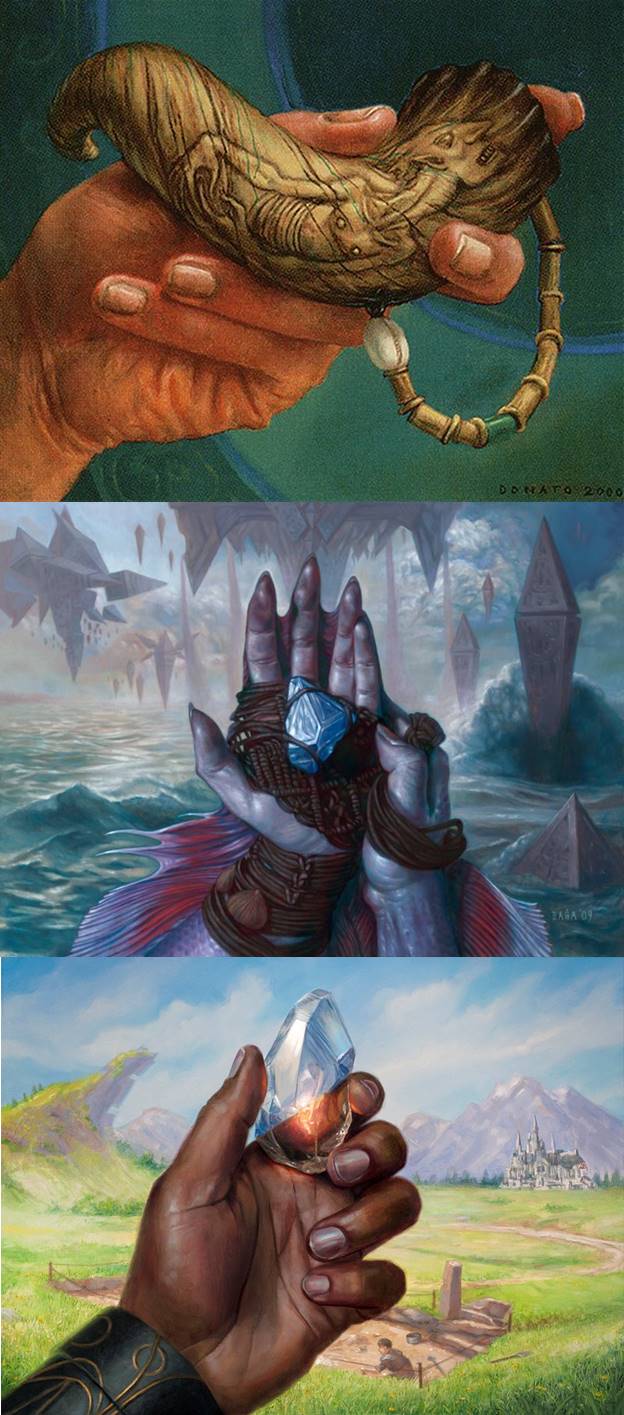
Troll-Horn Cameo by Donato Giancola, Mox Sapphire by Volkan Baga, Powerstone Shard by Lindsey Look
Pulled from the foothills of Hurloon, risen from the depths of the ocean, dug from the Dominarian earth; each object is held in one hand for purposeful admiration. They invite the viewer to join in the encounter and explore the newly discovered, yet obviously important treasure.
Precarious
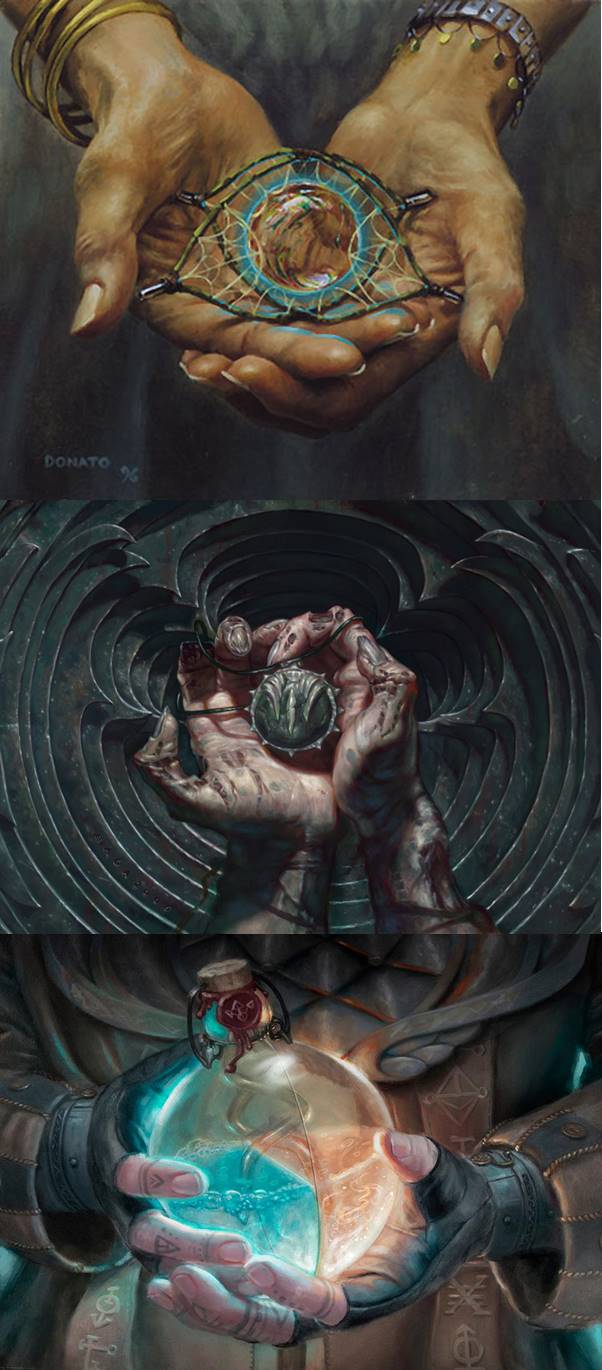
Juju Bubble by Donato Giancola, Mox Jet by Volkan Baga, Alchemist’s Vial by Lindsey Look
Each object holds within a silent danger, a hidden menace. Juju Bubble begs to be given to the viewer. Mox Jet rots the hands of its holder for no outwardly visible reason. You can feel the discomfort of the mage that is using both hands to balance Alchemist’s Vial like a child holding a full glass of water.
Ire
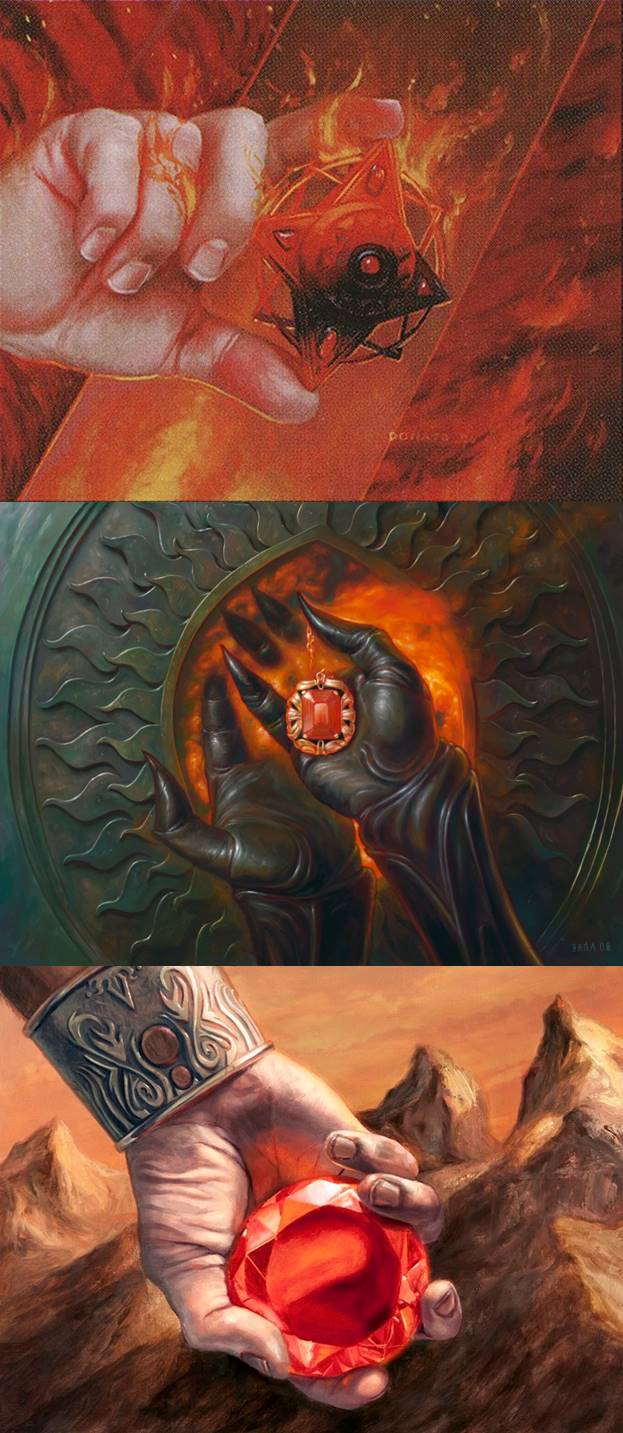
Iron Star by Donato Giancola, Mox Ruby by Volkan Baga, Fire Diamond by Lindsey Look
Iron Star can only be held in two fingers. Mox Ruby exudes such power that other cradling hand pulls away. And Fire Diamond’s emanation requires it to be held down and away from the audience within the work, placing it into direct sight of the viewer.
Value
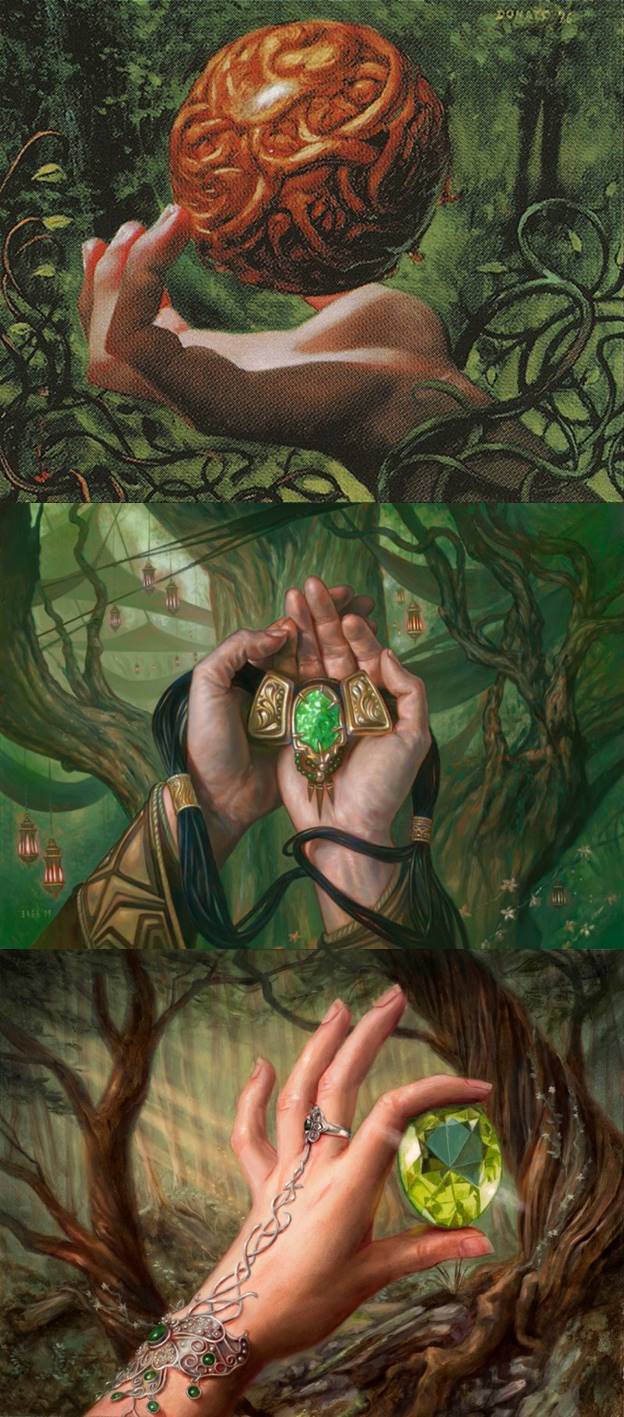
Wooden Sphere by Donato Giancola, Mox Emerald by Volkan Baga, Moss Diamond by Lindsey Look
Green has always been associated with envy. Can you feel it here? Think Gollum from The Lord of the Rings. These objects belong solely to their holder. They wants you to know they haves it, but only when they wants to show it you. Otherwise their personal admiration is perfectly acceptable. Their Precious.
Wrapping Up
I hoped you enjoyed this special blend of art history, in-depth exploration, and reconciliation pulling everything together. This type of article was inspired by Mike Linnemann’s Vorthos Art History, and you can check out my favorite of his here.
In my Twitter bio I say I “create connections that make meaning,” a statement born from the study of John Falk, the leader in informal learning environment educational theory and practice. I believe that Magic can be as much an informal learning environment as a museum, and at the very least a point of departure for discovery outside the game like the journey we just took. There are so many connections to be made, and if a lightbulb of meaning goes off for one of my readers I will have done my job. If you liked what I did here, please let me know and I’ll aim to do more in the future.
Remember, to see original #mtgart and other #vorthos related things, follow me on Twitter. Feel free to ask questions or retweet to continue the conversation. Thanks and I’ll see you next time!
Donny Caltrider has been playing Magic since 2002 and collecting original Magic art since 2017. He has an M.A. in Museum Studies from Johns Hopkins University and enjoys telling stories about art, objects, and the intersection of fantasy with real-life. You can find him on Twitter talking about #mtgart, museums, and other #vorthos related goodness. Follow along and continue the conversation!

